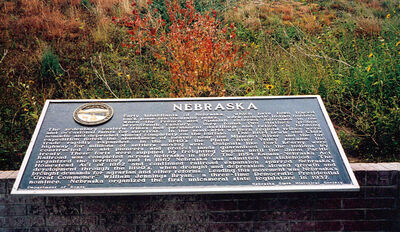Nebraska Historical Marker: Nebraska
Nebraska Historical Marker: Nebraska
Location
Mile marker 9, I-80 rest area, eastbound, Bushnell, Kimball County, Nebraska
View this marker's location 41.189961, -103.869112
View a map of all Nebraska historical markers, Browse Historical Marker Map
Marker Text
Early inhabitants of Nebraska, which have been traced back some ten thousand years, were nomadic Indian hunters. When the French and Spanish entered Nebraska in the seventeenth century, they found two distinct groups. The sedentary eastern tribes had permanent dwellings and relied on farming and occasional hunts for survival. In the semi-arid western regions tribes were nomadic and depended almost completely on the buffalo. The 1804 Lewis and Clark expedition noted the abundance of beaver near the Missouri River and the fur trade rapidly expanded. In the 1840's the Platte River Valley became the highway for millions of settlers moving west. Outposts like Fort Kearny were constructed to aid pioneers and protect lands guaranteed to the Indians by treaty. These forts were supplied by freighting wagons until the Union Pacific Railroad was completed across Nebraska in 1867. The 1854 Kansas-Nebraska Act organized the territory and in 1867 Nebraska was admitted to statehood. The Homestead Act of 1862 and continued railroad expansion spurred Nebraska's development through the 1890's, when drought and depression slowed growth and brought demands for agrarian and other reforms. Leading this movement was Nebraska's "Great Commoner" William Jennings Bryan, a three-time Democratic Presidential nominee. Nebraska organized the first unicameral state legislature in 1937.
Further Information
Bibliography
James E Potter, “Nebraska History on Nebraska Territory: A Reader’s Guide,” Nebraska History 84 (2003): 162-175
“Other Nebraska History Articles Relating to Nebraska Territory,” Nebraska History 84 (2003): 177-180
Frederick C Luebke, “Time, Place, and Culture in Nebraska History,” Nebraska History 69 (1988): 150-168
Marker program
See Nebraska Historical Marker Program for more information.
